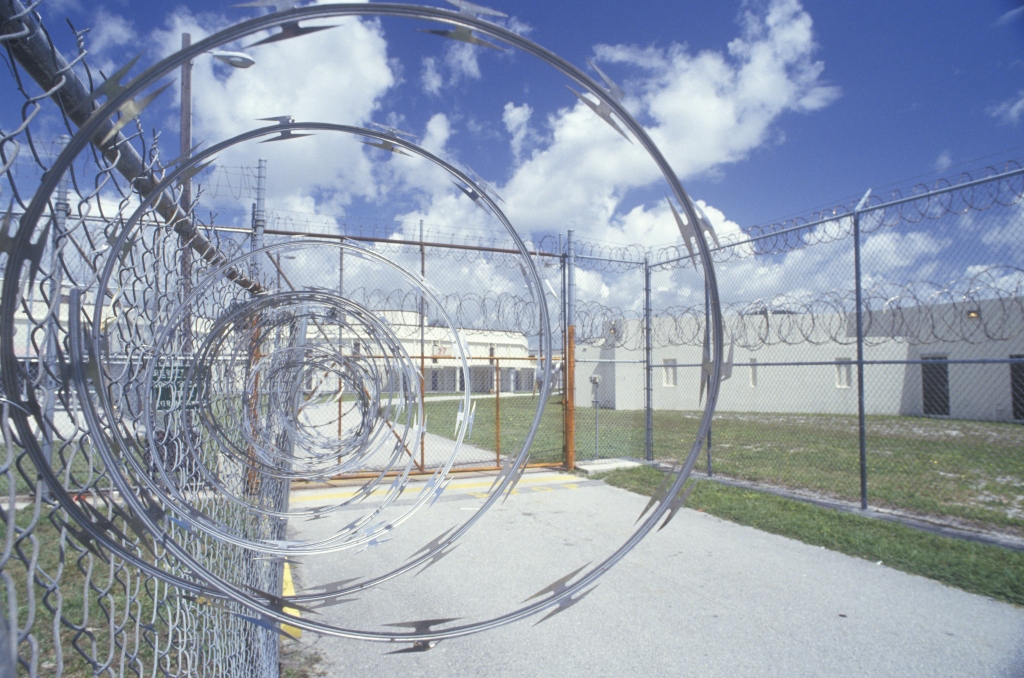Barbed-wire fence at Dade County Men’s Correctional Facility, Florida, USA. Photo: Joseph Sohm/Shutterstock.com
- About 96,000 prisoners are serving time in facilities around the state
- About 10% of prisoners in Florida are housed in privately-run facilities
- Most corrections’ dollars go toward guards and health care costs at prisons.
- Florida’s prisons are clustered mostly in North Florida. According to the U.S. Bureau of Labor Statistics, Northern Florida has the highest concentration of correctional jobs in the country. Prison guards and jailers account for roughly 56 of every 1,000 jobs in North Florida, compared to four per 1,000 jobs statewide.
Prisons are meant to rehabilitate prisoners and deter crime. Many prisons are at full capacity, however, and simply cannot house the number of inmates that need to be rehabilitated. There is growing concern that the state’s prison system is not prepared for such a task after years of budgetary neglect and cutbacks. Since the beginning of the recession in the early 2010s, state budget cuts have been the reason for slashed prison spending, staffing shortage and cuts to inmate programming.
As a result, lower salaries and hiring of inexperienced prison guards have been a real problem facing the jails and prisons around the state. In addition to this, there is also inmate idleness, increased gang activity and a near-constant flow of contraband into prisoner’s hands. Some prison advocates are asking for more money for prisons and others are calling on the Legislature to significantly reduce the state’s prison population by scaling back hardline sentencing policies.
There are challenges facing Florida prisons but there are also possible solutions. The first one starts with the administration of the prisons. Administration for the Florida Department of Corrections consists of employing about 24,000 people. The Department has an annual budget of more than $2 billion. Each inmate in custody costs the state of Florida about $22,000 a year. The state spends hardly anything on the rehabilitation of inmates. As an example, education and other inmate programs account for only 3% of the state corrections budget.
Other challenges faced in the system (and their possible solutions) are:
Leadership
Mark Inch, a former Army two-star general, became the seventh person in 10 years to take over one of the toughest jobs in state government as corrections secretary. Inch has been an advocate for more prison funding. Earlier this year Mark Inch appeared before the state House Justice Subcommittee to ask for money to increase prison staffing and guard pay.
Aging Infrastructure
Florida’s public prisons have been run as such for more than 40 years. According to correctional employees, years of underfunding have led to low or no maintenance of the buildings which house the inmates, and nearly two-thirds of the prisons do not have air conditioning.
Prison Guard Turnover
The annual turnover rate among state prison guards is 36%, according to FloridaTrend.com. Understaffing and low pay are contributing factors to this problem. Hiring inexperienced prison guards is also a problem the system is facing. Many guards have been on the job for less than two years. Corruption is rampant among the guards, too. Last year alone 103 state corrections employees were arrested on charges related to contraband, bribery or other misconduct while on the job, up from the number of 81 arrests from the previous year.
“The starting salary for a corrections officer is $33,500. Let’s be honest, there’s not a lot of people who want to take a job where you’re risking your life for $33,500,” says Jimmy Baiardi, of the Florida Police Benevolent Association, the union representing prison guards.
Inmates and Gang Activity
Florida is the third-largest U.S. state and has the third-largest inmate population among states (with the 10th highest incarceration rate in the nation) It is also reported inmates that are released from prison do so with more criminal intent than from when they first went in. This is because many prisoners join gangs inside of the prison as a form of protection against violence and/or to take advantage of staff shortages. Prisoner-on-prisoner and prisoner-on-staff assaults increased between 2008 and 2018, 67% and 46%, respectively, while incidents of staff using force against prisoners rose 54%.
No Education Programming
Two-thirds of prisoners lack a high school education, and a third of Florida prisoners read below a sixth-grade level. Not many prisoners are even getting their GEDs. Due to lack of resources, state prisons limit eligibility for adult basic education for those who have less than three years left to serve in their sentence.
Only those due to be released in five years or less can participate in vocational training.
Short and Long Sentences
Due to the opioid crisis, mandatory minimums have drawn renewed scrutiny. The James Madison Institute, a conservative think tank in Tallahassee, estimates that imprisoning low-level drug offenders costs Florida taxpayers more than $100 million a year.
Under Florida sentencing guidelines, someone arrested with seven to 14 grams of oxycodone faces a mandatory minimum of three years in prison. Possessing 14 to 25 grams of oxycodone has a seven-year mandatory minimum sentence, and possessing 25 to 100 grams has a mandatory minimum of 15 years.
Some lawmakers want to cut Florida’s time-served requirement to 65% for non-violent offenders who demonstrate good behavior in prison. State Senator Jeff Brandes, chair of the state Appropriations Subcommittee on Criminal and Civil Justice, argues that Florida’s prison system is at a breaking point: Either the state dramatically increases funding to keep pace with prison costs, taking away from other budget priorities, or it scales back long prison sentences and lowers costs.

